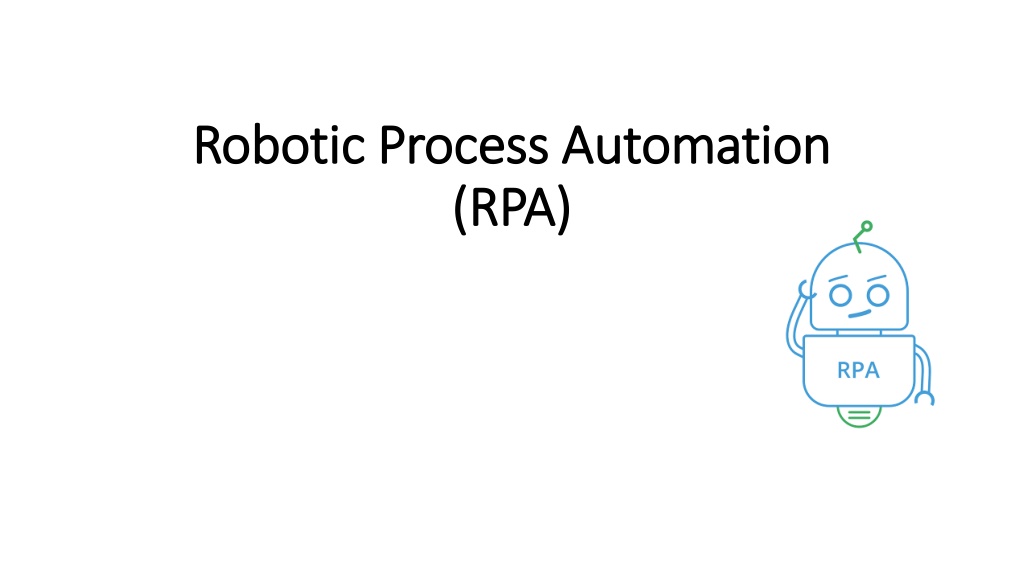Understanding Robotic Process Automation (RPA) in Business
Robotic Process Automation (RPA) allows organizations to automate labor-intensive tasks across applications and systems. It enables software bots to interact with various platforms, providing benefits such as increased efficiency and accuracy. Learn about RPA implementation, best practices, and the differences between test automation and RPA.
Download Presentation

Please find below an Image/Link to download the presentation.
The content on the website is provided AS IS for your information and personal use only. It may not be sold, licensed, or shared on other websites without obtaining consent from the author. Download presentation by click this link. If you encounter any issues during the download, it is possible that the publisher has removed the file from their server.
E N D
Presentation Transcript
Robotic Process Automation Robotic Process Automation (RPA) (RPA)
What is Robotic Process Automation? What is Robotic Process Automation? Robotics Process Automation(RPA) allows organizations to automate task just like a human being was doing them across application and systems. RPA can be used to automate workflow, infrastructure, back office process which are labor intensive. These software bots can interact with an in-house application, website, user portal, etc.
AGENDA What is Robotic Process Automation? Why Robotic Process Automation? Example of RPA Differences between Test Automation and RPA RPA Implementation Methodology Best Practices of RPA Implementation General Use of RPA Application of RPA Robotic Process Automation tools Benefits of RPA
Why Robotic Process Automation? Why Robotic Process Automation?
Example of RPA Example of RPA
Example of RPA Example of RPA Description Can be Automated via RPA? Open invoice email from the supplier and print it for records Yes Barcode Scanning Manual Create work item in a legacy software system Yes Enter PO to retrieve Invoices Yes Check supplier name is correct or not? Yes Key Invoice, Data and Amount Yes Yes Check if Amount is matches or not? Yes If amount match is yes the Matched Invoice, Calculate Tax Complete Invoice Processing Yes Work Item Closed Yes
Differences between Test Automation and RPA Differences between Test Automation and RPA Parameter Test Automation RPA Reduce headcount through automation Goal Reduce Test execution time through automation Automate repetitive Business processes Task Automate repetitive Test Cases Wizard-driven, and coding knowledge not required Coding Coding knowledge required to create Test Scripts Supports limited software environment. Example: Selenium can support only web applications. Supports a wide array of software environments Tech Approach Data entry, forms, loan processing, is automated Example Test cases are automated Test Automation can be run on QA, Production, Performance, UAT environments RPA is usually run only on production environments Application It can automate a product as well as a service. Implementation It can automate a product. Can be used across the board by all stakeholders. Users Limited to technical users.
RPA Implementation Methodology RPA Implementation Methodology Planning/Analysis Development/Bot Development Testing Support & Maintenance
Best Practices of RPA Implementation Best Practices of RPA Implementation One should consider business impact before opting for RPA process Define and focus on the desired ROI Focus on targeting larger groups and automating large, impactful processes Combine attended and unattended RPA Poor design, change management can wreak havoc Don't forget the impact on people
General Use of RPA General Use of RPA
Application of RPA Application of RPA
Robotic Process Automation tools Robotic Process Automation tools Selection of RPA Tool should be based on following 4 parameters: Data: Easy of reading and writing business data into multiple systems Type of Tasks mainly performed: Ease of configuring rules-based or knowledge-based processes. Interoperability: Tools should work across multiple applications AI: Built-in AI support to mimic human users Popular Robotic Automation Tools: Blue prism, Automation AnyWhere, UiPath etc..
Benefits of RPA Benefits of RPA Large numbers of the process can easily have automated. Cost are reduced significantly as the RPA takes care of repetitive task and saves precious time and resources. Programming skills are not needed to configure a software robot. Thus, any non-technical staff can set up a bot or even record their steps to automate the process. Robotic process automation support and allows all regular compliance process, with error-free auditing. The robotic software can rapidly model and deploy the automation process. The defects are tracked for each test case story and the sprint. Effective, seamless Build & Release Management Real time visibility into bug/defect discovery There is no human business which means there is no need for time for the requirement of training. Software robots do not get tired. It increases which helps to increase the scalability
Disadvantages of RPA Disadvantages of RPA The bot is limited to the speed of the application Even small changes made in the automation application will need the robots to be reconfigured.

























